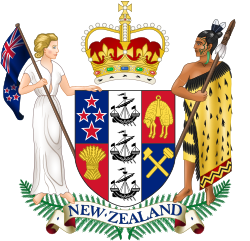| Coat of arms of New Zealand | |
|---|---|
 | |
| Versions | |
 1911–1956 | |
| Armiger | Charles III in Right of New Zealand |
| Shield | Quarterly: Azure and Gules on a Pale Argent three Lymphads Sable, in the first Quarter four Mullets in Cross of the last each surmounted by a Mullet of the second (representing the Constellation of the Southern Cross), in the second Quarter a Fleece, in the third a Garb, and in the Fourth two Mining Hammers in Saltire all Or.[1] |
| Supporters | On the dexter side a European female Figure proper vested Argent supporting in the dexter hand a flagstaff proper hoisted thereon the Ensign of the Dominion of New Zealand, and on the sinister side a Maori Rangatira (chieftain) vested proper holding in his dexter hand a Taiaha (halbert) all proper.[1] |
| Compartment | Silver fern leaves |
| Motto | "New Zealand"[2] |
The coat of arms of New Zealand (Māori: Te Tohu Pakanga o Aotearoa[3]) is the heraldic symbol representing the South Pacific island country of New Zealand. Its design reflects New Zealand's history as a bicultural nation, with a European female figure on one side and a Māori rangatira (chief) on the other. The symbols on the central shield represent New Zealand's trade, agriculture and industry, and a Crown represents New Zealand's status as a constitutional monarchy.
The arms were granted by warrant of King George V on 26 August 1911, and modified by Queen Elizabeth II in 1956. While the use of the coat of arms is restricted to the New Zealand Government, the symbol enjoys wide use on state decorations; it appears on the uniform of the police and is on the cover of the national passport.
- ^ a b "New Zealand Coat of Arms" (PDF). The New Zealand Gazette. 11 January 1912. p. 52.
- ^ "Coat of Arms". www.mch.govt.nz. Ministry for Culture and Heritage. Retrieved 23 August 2017.
- ^ Wilson, John (16 September 2016). "Tuakiri o Aotearoa me te kāwanatanga - Te tuakiri o Aotearoa" (in Māori). Te Ara: The Encyclopedia of New Zealand. Retrieved 14 July 2019.